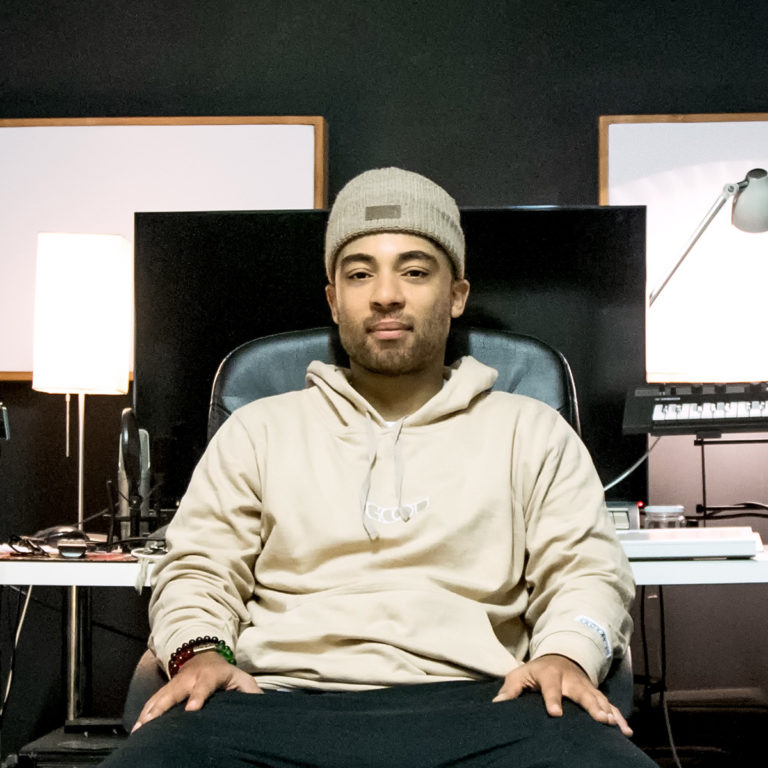Alan Mensah, better known by his stage name Ghanaian Stallion, has become a mainstay in the German hip hop scene by providing chart-topping beats for Megaloh, producing for the group BSMG and releasing instrumental albums such as the acclaimed Soul Fruits EP. In conversation with Kabuki for Native Instruments, Mensah provides insights into studio approach, and explains how MASCHINE aids him in the development of new musical ideas.
First things first: what does your current setup look like? How are you producing music these days?
Actually, my setup is pretty basic. I have an Apollo Twin [soundcard], a MacBook, a few midi-keyboards and a Maschine Mikro. That’s how I produce more or less all of my music, or at least this is how it starts. I haven’t really been missing anything so far, as I’m the type of person that likes to tinker away until I come up what I had in mind. I usually start out with a sample or a loop, and then take it from there. There are always several phases: when I start writing a beat, I try to finish it to the point where I can send it out. Then, when somebody like Megaloh starts writing to the beat, I look for ways to develop it. I work with musicians who can add parts, which is a good way to expand the arrangement: for example, by writing a C-part, and by adding more musicality to the whole beat.
Are you the type of person who tries to translate the idea you have in your mind, or do you experiment with the available elements until the magic happens?
A little bit of both. When I hear something that inspires me, I immediately try to figure out in which direction I should take it. I’m not specialised in one particular sound, and even if all my productions share a common vibe, there’s quite a bit of variety to my work. I produced classic boom-bap stuff, but also afrobeat. That’s why it’s very important to me to first decide in which direction the beat is heading. This variety is one of my strengths, but it sometimes can also be a hindrance. “Should I turn this into a trap beat, or flip the sample for an afro vibe? I could also add a drum break here…”. You get the idea.

A blessing and a curse. When we worked together I found it very interesting how you structure your drum kits. Can you talk a little bit about the process of selecting your sounds?
That’s something I developed over the years. At first it was all about layering three kicks and three snares to give the drums more knock, because I had no idea how to make a kick sound big using compressor and EQ, I didn’t know about parallel drum compression. So you would just stack three kicks to achieve a similar effect. [Mastering Engineer] Nils Faller, who has always been something of a mentor to me, told me once “Make sure to use quality elements, then you can do much more with them later”. I collected a substantial library over the years, and luckily it’s super easy to integrate this into Maschine. Once you do this, you can access your favorite sounds right from the Maschine hardware. All you need to do is assign the sample library folders in the preferences, and then the sounds appear in the Maschine browser. You can also tag them with categories such as kicks or snares for an even faster access. I’m not the type of producer that uses a library of 10 kicks and 10 snares in every single one of my productions. Instead, I often use new sounds. That’s especially important as I cover such a wide area.
What I find particularly interesting about your beats is how you combine synthetic drum sounds with sampled drum loops.
That’s a major part of my music-making philosophy. I grew up with 90s hip hop, and people like Mobb Deep and Premier had a big influence on me. This is one of the reasons why it’s so important for me to always have some type of ‘soul’ in my productions. On the other hand I’m also somebody who is up to date with the music that is happening right now, and who likes to combine these classic organic vibes with the sound of today. So I feel that when I’m working on a trap beat it’s perfectly fine to also add a sampled drum loop. The people I admire in terms of their productions, the guys on Kendrick’s team, the guys on Drake’s team, or somebody like Boi-1da, they all follow that approach. They have that spirit from back in the day, they know how to inject ‘soul’ into their productions, but they also know what’s happening right now. They know that you can’t just use a Curtis Mayfield break and expect your beat to be played in the clubs at this point in time. But there are ways to combine this, and that’s the sound that I stand for.
Since you’re known for your sample-based beats I was wondering if you can share any specific tips or techniques in that regard?
That all depends on the type of sample, and the possibilities it gives you. For example, does it contain drums? Sometimes you just have a sample and run it backwards and think to yourself, ‘Wow, that sounds cool!’. Back in the day I used to chop my samples into tiny pieces, but right now my approach is more to produce a loop that sounds like it was recorded that way using individual chops.
So it’s more like rearranging the sample.
A new arrangement, so that the result doesn’t resemble the original anymore but still has that warmth. For example, if I would play you the sample for ‘Lang Lebe Afrika‘ then you wouldn’t catch it. Often it’s a feeling, a vibe. I find myself in situations where I can’t get anything done with a sample or a chop because I’m not in the mood, and other times I can do a whole beat with just a tiny fragment because I’m in the flow. But essentially it’s like this, when I hear something that I like, then I record it and listen to it for a while. And I like to experiment, I’m always amazed what can happen when you take a sample, open the right plug-in and all of a sudden it becomes something entirely different.
Stay open to all possibilities, and don’t lose the experimental spirit. Because that’s when inspiration comes knocking, and the beat starts to write itself.
Exactly. If you always have a standard procedure then this might help to develop one specific sound, and when somebody wants that particular thing, they know they have to come to you. My ‘problem’, if you want to call it that, is that sometimes people are into just one beat I made, and then expect just that vibe from me. And when I send them beats and also include stuff that has a different vibe, because it is also part of my style, then this can sometimes confuse people. On the other hand, you have more possibilities this way, and one day you might produce a single for Kalim, and on the next day you are working on an album track for Joy Denalane. This is definitely something I want to keep developing.
I like that statement. Next question, on the BSMG album I hear a lot of trap influences, especially when it comes to the basslines. Do you use samples, and synthesizers?
I often use 808- kickdrum samples for the basslines, but sometimes also synths. On a track like ‘Lang Lebe Afrika’, the drums already have a heavy trap vibe, so recording a live electric bass guitar to contrast, adds a little twist. Or on ‘Wer Hat Die Hitze’ with Trettmann, that is a classic trap-beat but we recorded a live bassline to it. That’s a combination I like a lot.
So you have the 808 for the low end, and the live electric bass for the transients and presence. While we’re talking about live instrumentation, you worked with Tony Allen, the legendary drummer for Fela Kuti and Africa 70. How did this happen?
It was Christian Prommer who made the connection. He worked with Tony in the past, and after he heard the Regenmacher album he suggested getting Tony and Megaloh in touch. In the end we worked for two days in the studio and produced afrobeat mixes to existing tracks from the album. Tony was so into the sound that we also wrote a new track on the spot. Before the session we created arrangements, so that Tony could easily add new elements with the drum kit. We made sure that he was in his comfort zone, and he really felt the vibe and understood what we’re about. A great experience!
Do you have a tip on how to transform an idea as quickly as possible into reality?
I try to not spend too much time on the details when I’m starting out, instead my goal is to capture the vibe right away. Once I get the feeling that the loop is working and that the drums are providing the right kind of support, that’s when I start looking more closely, and might say, ‘This kick drum isn’t so great, and the snare could also use some work.’ So I try to lay down the foundation as quickly as possible, and then use this for further inspiration. A feature that helps with this approach is the ‘Ideas View’ that has recently been added to the Maschine Sequencer. It’s a great tool for trying out different pattern variations, and once you find something that works it’s also really easy transfer this into the arrangement. By using this approach, you can arrange a beat in no time.
It’s easy to get lost in the details when you start working on a beat, and then it becomes hard to finish it. Your method of starting with the big picture and working your way down to the details is a great approach for not losing the vibe.
That’s something I learned over the years. At first you write a beat and just layer stuff, but I learned from working with accomplished musicians like Kahedi that they start out relatively simple. It’s not about having this killer production, because you want to write a song that still leaves enough room for the featured artist to provide his input. And when the artist records something to your beat, it opens up different aspects and possibilities. This something that I like, don’t overcook the beat when you start, but let things breathe.
Focus on the vibe, because if the vibe ain’t right you can’t fix that with a plug-in.
I’m a vibe guy, but I also know that I have to get more into the technical aspects. That’s why I’m currently updating my setup, because I feel I reached my limits. That takes me a while, I have my workflows, I know how to accomplish certain things. Still, I realize that this is something I need to work on. But you can learn about technical aspects, you can’t learn the vibe!
photo credits: Yvonne Hartmann





















